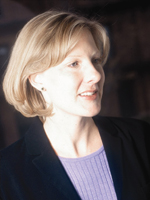Gerken Demystifies Mysteries of Windsor at BU Law Annual Distinguished Lecture
Complex, interlocking gears at work in Kennedy’s so-called ‘muddle-headed’ opinion, speaker contends

Boston University School of Law welcomed J. Skelly Wright Professor of Law Heather K. Gerken of Yale Law School on October 2, 2014, for the School’s 2014 Annual Distinguished Lecture. In “The Interlocking Gears of Rights and Structure: Why the Critics Are Wrong About US v. Windsor,” she explained her understanding of the means employed by Justice Kennedy in reaching that landmark opinion.
Professor Gerken began by saying that BU Law is a good place to lecture about Windsor, the 2013 Supreme Court opinion that held that the Defense of Marriage Act (DOMA) deprived same-sex couples of Fifth Amendment equal protection rights, because so many of the School’s faculty have been involved in or written about related cases. However, she said, she hoped to offer a “new and tentative take on Windsor” to the robust debate.
“There’s a little bit of mad genius to Windsor,” she said. Her assessment comes from Kennedy’s much-criticized opinion, which she praises in part because it “recognizes that rights and structure are like two interlocking gears.”
Many other takes on the case, Professor Gerken said, have appreciated the outcome while finding little to appreciate in the rest of the opinion—the academic equivalent of “loving the sinner but hating the sin.”
The Kennedy opinion starts out with a federalism focus, she said, mentioning “states’ rights no fewer than 11 times,” but then switches gears, and Kennedy’s “favorite themes begin to emerge.”
“Aha! You think, ‘It’s a liberty decision!’” she said. Soon though, you see there’s even more to the opinion.
Comparisons of Windsor to Romer v. Evans (517 U.S. 620 (1996)) made by BU Law Professor Linda McClain have merits, Professor Gerken said, because Windsor manages to invalidate DOMA without designating gay and lesbian people as a protected class. The opinion, she said, reads as if there’s not yet a 14th Amendment right to be claimed, but there will be one soon.
Windsor’s mysteries are deep, Professor Gerken said, and the “traditional rights-structure divide” does not accommodate the decision. Even the doctrinal test Kennedy has used to invalidate DOMA is a mystery, she said. However, she still chooses to decipher the opinion derided by other scholars as “muddle-headed.”
Forcing a decision between federalism and liberty, or between federalism and equality, is a mistake “made throughout constitutional theory,” Professor Gerken said. She cautioned: “If you don’t understand the way federalism and rights work together,” you miss the point of Windsor. The point requires both concepts, “and that is as it should be.”
The conception of the same-sex marriage issue shifted when Massachusetts and other states and cities began issuing marriage licenses to same-sex couples—forcing political leaders to shift gears, Professor Gerken said.
“What do you do when you see someone standing on a soapbox?” she asked. “You walk on by.”
That illustrates that the First Amendment argument is not enough today, she said. Dissenters cannot be confined to theoretical arguments, and national movements, she said, rarely start as national movements. They must make “use of structural arrangements—the gifts that federalism affords.”
Another theme of her lecture was the subject of her 2005 article “Dissenting by Deciding,” a concept that she said further demystifies the “mysteries of Windsor.” Dissent, Professor Gerken argues, is a powerful tool, and federalism is not its enemy
“Rights are demanded, not bequeathed,” she said, and Windsor was right to recognize that.
“When we rethink the content of our characters … the content of our Constitution must be rethought, as well,” Professor Gerken said.
Finally, Professor Gerken explored the “rule of recognition problem,” which she said requires legislation to be passed by “a lot of states.”
Windsor, she said, was about “clearing the channels of political change” in light of the increasing “brouhaha” over same-sex marriage, which had signaled to the Court that the national “consensus is unravelling.”
Kennedy’s opinion allows proponents of marriage equality to “take full advantage” and allows states to “tug the federal government along with them,” she added. Kennedy insisted that the federal government stand aside, Professor Gerken said, so as to ensure that the gears of “rights and structure were free to move,” and also so the “small gears” of the states could move the “large national gear.”
She concluded by asserting that other reads of Windsor do not square with the “strange rhetoric of the opinion” and that her view offers an “important constitutional truth,” that rights and structure, “long thought to be inimical,” are actually working together.
Finally, Professor Gerken answered several student questions and engaged in discussion with Professors Linda McClain, Jack Beermann, Gary Lawson, and Kristin Collins about how her views on Windsor have wider implications, the difference between the “totally powerless” and the “muscular powerless” in affecting change, some points to be explored in greater detail in her forthcoming article, and more.
About Professor Gerken
Professor Gerken primarily researches election law and constitutional law. She won teaching awards while on the Harvard faculty from 2000 to 2005 and at Yale, where she has taught since 2006, and also was named one of the nation’s 26 best law teachers. Her most recent book is The Democracy Index: Why Our Election System is Failing and How to Fix It (Princeton University Press 2009). Her “Democracy Index” concept became reality with the Pew Charitable Trust’s Elections Performance Index. An article based on her lecture at BU Law will be published in a forthcoming edition of the Boston University Law Review.
Reported by Jaime Margolis (’16)